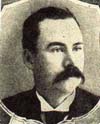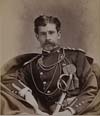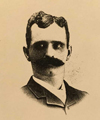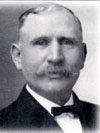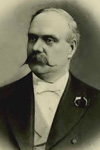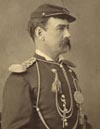Thomas Joseph Callan (left) died in Yonkers, New York, on March 5, 1908, and was buried in Holy Sepulchre Cemetery in East Orange, New Jersey. He was a Private in Company B who was with the pack train and in the hilltop fight. He was awarded the Medal of Honor for his actions there. His obituary, which was printed in numerous newspapers across the country, stated a different reason for the award. The man deserved better.
Thomas Patrick Downing was born on March 6, 1856, in Limerick, Ireland. He was a Private in Company I who was killed with Custer’s Column during the battle.
John Foley died at Barnes Hospital in Washington, D.C., on March 6, 1926, and was buried in the Soldier’s Home National Cemetery there. He was a Private in Company K who participated in the hilltop fight.
James Calhoun (left) married Margaret Emma Custer on March 7, 1872. Maggie Custer lost her husband, three brothers (George, Tom, and Boston) and a nephew, Autie Reed, during the battle.
Edwin Philip Eckerson was born on March 8, 1850, in Fort Vancouver, Washington Territory. He was a Second Lieutenant in Company L who was en route at the time of the battle, so he was not present.
Charles William Larned (left) was born in New York, New York, on March 9, 1850. He was an 1870 graduate of the United States Military Academy at West Point. He was a Second Lieutenant in Company F who was on detached service, serving as an assistant professor of drawing at West Point, at the time of the battle.
Climbs the Bluff died of inflammation of the lungs on March 9, 1880, at Fort Abraham Lincoln, Dakota Territory, and was buried in the Indian Scout Cemetery. He was an Arikara Scout on detached service. At the time of the battle, he was carrying messages from the Yellowstone River Depot to the 7th Cavalry, so he did not participate in the battle.
James Boggs was born on March 10, 1846, in Carlisle, Pennsylvania. He was a Private in Company H who was not present at the battle. He was on the 7th Cavalry roster at the time of the battle, but he had been discharged for medical reasons on May 15, 1876.
Morris Hedding Thompson (left) was born in Waukegan, Illinois, on March 10, 1852. He was a Private in Company E who was not present during the battle due to detached service at Fort Abraham Lincoln where he was in charge of the company garden.
Charles A. Windolph (right) died on March 11, 1950, in Lead, South Dakota, and was buried in the Black Hills National Cemetery in Sturgis. He was the last white survivor of the battle. He was a Private in Company H who was wounded in the hilltop fight for which he was awarded the Purple Heart, and he helped get water for the wounded for which he was awarded the Medal of Honor.

